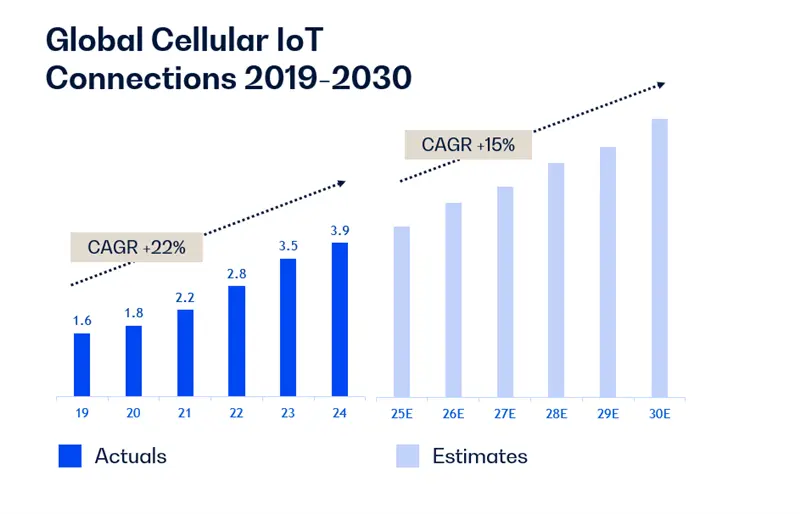
Smart Device Networks: FAQ Answered by Elisa and Huld
Read Elisa’s Mika Flinck and Taavi Mattila’s and Huld’s Iikka Taanila’s thoughts on the future of smart device networks.
As old network technologies are phased out, space opens up for new, more energy-efficient and safe solutions. What are these technologies – and how they affect business and consumers?
In this blog, Mika Flinck and Taavi Mattila from Elisa and Iikka Taanila from Huld answer the most asked questions. Read below experts’ views on the new wave of online technologies.
1. How network technologies develop – and which solutions will soon be history?
Mika and Taavi: The development of network technologies has shifted from simply increasing data speed to energy efficiency. Of the old technologies, 3G was removed from Elisa’s network at the end of 2023, and 2G is phasing out as the decade turns. At the same time, the role of 5G is constantly growing. Already, there are versatile options available for IoT use, such as NB-IoT, LTE-M and the lighter 5G RedCap.
Device identity management is also evolving – eSIMs have been introduced alongside traditional SIM cards, and the built-in iSIM will be the next wave. The new SGP.32 standard enables remote management of eSIM profiles and carrier switching without physical changes. The technology, which is familiar from consumer devices, is now making a strong impact on the IoT side as well.
Iikka: I remember just five years ago, there was a lot of buzz in Finland about low-power NB-IoT solutions and eSIM technology that makes it easier to manage smart devices. Energy efficiency is still a hot topic, but faster data transfer and better compatibility in the international market have increasingly emerged. In relation to these themes, in addition to 5G RedCap, LTE Cat1 bis also seems very interesting from the device manufacturers point-of-view.
2. How do new network technologies improve data transmission and save energy?
Mika and Taavi: The power consumption of IoT devices depends on how often they send data and how they use the network connection. The latest mobile technologies, such as NB-IoT and LTE-M, are specifically designed to be low-power, allowing devices to last up to more than 15 years. Power consumption is also reduced by intelligent power-saving features such as Power Saving Mode (PSM) and Extended Discontinuous Reception (eDRX), which allow devices to be in sleep mode when not used.
Faster and near-real-time data transfer is matched by 5G, which very low latency (up to 1 ms) is important for industrial automation and self-driving vehicles, for example. In addition, 5G supports a massive number of devices per square kilometer.
In practice, different technologies serve different uses: NB-IoT is well suited for static measuring devices that rarely transmit data. LTE-M, on the other hand, supports mobile devices such as smartwatches and a higher data transfer requirement. 5G RedCap brings a new generation to the market for applications that demand speed and efficiency.
Iikka: Choosing the right network technology will take the device towards low-power or faster data transfer, but that alone is not enough. To make a device low-power, the modem, microcontroller, memory and power supply must be optimized – not to mention the firmware!
One of the most interesting technological innovations is certainly the development of batteries. The lifespan, reliability and performance of batteries will be the main themes in the design of future devices.

Source: IoT Analytics (2024)
3. How do changes in online technologies shape business operations and how it can be seen in products and consumers’ everyday lives?
Mika and Taavi: New mobile network technologies enable new innovations. For example, the 4G network combines several advantages: reasonable network latency and data transfer capacity, as well as support for low-power IoT technologies such as NB-IoT and LTE-M. Such a combination has not previously been possible in 2G or 3G networks. With new technologies, long-lasting and future-proof solutions are also available. Solutions based on 2G and 3G networks are no longer recommended to be installed, as their era will come to an end.
Iikka: Developing network technologies really do create the basis for new innovations. There are a wide range of options available that give companies the opportunity to develop different solutions for different use cases.
For example, in industry, higher data transfer capacity and lower latency may provide a real-time view of the instrument that can be used to optimize production. Smart water meters found at home, together with consumption views, can guide us towards more sustainable water consumption.
In addition to product development, new online technologies have also significantly accelerated the development of various services, such as healthcare and well-being services. This has a direct impact on the user experience – and on our everyday lives.
4. How to ensure the security of smart devices in the era of developing network technologies?
Mika and Taavi: New network technologies, such as 5G, have stronger security features built in, such as advanced encryption mechanisms. For both businesses and consumers, this means better protection against web-based threats. Elisa supports its customers by offering comprehensive information security and cyber security services.
Iikka: The explosive growth in the networked smart devices is increasingly exposing devices (and services) to attacks. At the beginning of March, Nokia’s Deepfield Emergency Response Team (ERT) reported on one of the world’s largest DDoS attacks which exploited security flaws in more than 30,000 smart devices.
On the network side, monitoring and improving information security helps, but device manufacturers also have a big responsibility for information security. Secure Chip, Secure Boot and Secure Development Lifecycle are themes that every device manufacturer should be familiar with.
Both: And let’s not forget the users! Increasing awareness of information security issues is important, but actions also have an impact. Each of us should regularly check for the latest updates on our smart devices and also install them as soon as possible.
Read more
- Elisa IoT services
- IoT Analytics – 2019-2030 Global Cellular IoT Connectivity Tracker & Analytics
- Huld’s IoT services
Meet Huld and Elisa:
Subcontracting Fair, 30.9 – 2.10.2025, Tampere Exhibition and Sports Centre
Teknologia 25, 4.11 – 6.11.2025, Helsinki Exhibition and Convention Centre